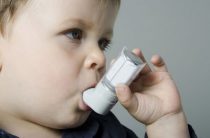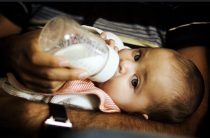Allergy in children is an acute immune response to the intake of a safe substance - an allergen. Although it is not capable of harming the child, it can cause allergic-type reactions, due to the high sensitivity of the child's immune system. Just starting to form, the child's immunity only learns to respond correctly to various stimuli, which does not happen without excesses.
At an early age, most of the allergic reactions that occur are temporary. The child literally “outgrows” the allergy. But in some cases, this disease can persist. It is especially necessary to be vigilant to parents who themselves suffer from allergies, because in this case, transmission as a hereditary disease is possible.
Separately, we should talk about food allergies in a child, to find out the cause of which, with a fairly rapid onset of symptoms, is not difficult. Its appearance is due to the peculiarities of the gastrointestinal tract at this age, which has not yet completed its formation. The child has enzyme deficiency, as well as beneficial microflora. In a word, those components that are directly involved in the digestion of food. As a result, the child's blood contains incompletely processed food proteins. The baby's body mistakenly takes them for harmful agents and tries to remove them, which provokes allergy symptoms.
What causes an allergy in a child?
There is a list of typical allergens. These include substances, the interaction with which causes allergies many times more often than other components. To find out what the child is allergic to, the doctor conducts a survey of parents to find out if there are typical allergens in the diet or the environment of the baby.
Typical allergens:
- Food components. It is the wrong diet that is the main cause of allergies in the baby. And so, the following products are considered typical food allergens: egg yolks, honey and other bee products, chocolate, pastries, whole cow's milk, cereals containing gluten (oats, wheat, barley), flour, carrots, citrus fruits, tomatoes, various nuts.
- Plant pollen, which is difficult to protect against because it is microscopic in size and carried by the wind over long distances;
- Animal wool, as well as bird plumage. In some cases, there may be an allergy to the hair of any animal;
- Medications (especially antibiotics and anti-inflammatory drugs);
- Household chemicals that surround the child everywhere. The children's body is extremely sensitive to various synthetic components.
Allergy symptoms in children
You can find out what a child is allergic to by observing its symptoms, which are very specific. However, allergy symptoms are a very heterogeneous phenomenon. Therefore, in different children, the same type of allergy may have a different symptomatic manifestation.
- Skin rashes.
Most often, this symptom occurs as part of a food allergy. Skin rash can be both in the form of scaly areas, and in the form of small nodules filled with a specific fluid. Skin rashes are often accompanied by severe itching, in places of their localization;
- Allergic dry cough and acute bouts of sneezing.
These manifestations are associated with an attempt by the body to get rid of the allergen that has got inside;
- Symptoms of rhinitis.
They cause inflammatory processes that are localized within the mucous membrane. They greatly complicate breathing, along with them goes hand in hand with an intense runny nose;
- Swelling of the skin tissue and mucous membrane.
During an allergic reaction, local blood vessels located in the area of the allergic reaction secrete a large amount of fluid that penetrates into the tissue cavity. This leads to the fact that the skin and mucous membranes swell. Swelling of the larynx is the most dangerous symptom, as it can provoke suffocation.
- Disorders of the digestive tract.
The big problem that makes it difficult to find out what the child is allergic to is that the symptoms of allergy and dysbacteriosis in some cases are indistinguishable. In view of this, differential diagnosis should be carried out between these diseases.
How can I find out what my child is allergic to?
An allergy in a child may not be manifested immediately after interaction with the allergen, but after a certain time period. Sometimes, especially in the case of food allergies, it may take a week or more for the first symptoms to appear. Dietary measures, in this case, can help you find out the nature of the food allergen. To begin with, you need to pay close attention to whether there are foods in the baby's diet that have significant allergenic potential. These include: all kinds of nuts, bee products, cocoa and chocolate, seafood, wheat flour products, wheat, oatmeal, barley, tomatoes, carrots, beets, bell peppers, eggs.
Each of these foods should be eliminated for two weeks. If you see that the child's allergy symptoms are gradually fading away (they begin to decrease after the absence of contact with the allergen), then the cause is some highly allergenic product. Gradually, once every three days, give your child one of these products, along with hypoallergenic ones. Keep a close eye on your child's behavior, skin reactions, and other factors that will help you figure out if allergies are related to certain foods.
It should also be taken into account that, depending on the natural conditions in which the child lives, the exclusion of such a significant number of suspicious products may not be appropriate. After all, in addition to the risk of developing allergies, they are also primarily products with a high biological value. Therefore, if the doctor finds it difficult to choose a replacement worthy of nutritional value, then it is necessary to remove the products from the baby's diet one by one.
Tests for allergies in a child
To find out what exactly the baby is allergic to, special laboratory diagnostic measures are involved. They allow with a high degree of accuracy to determine not only the nature of the allergen, but also to obtain information regarding the characteristics of the course of the disease in a child and the mechanisms of the immune response. The use of special diagnostic procedures can shed light on numerous aspects of allergic disease. But it is worth remembering that the diagnosis of allergies in children has its own specifics. So, some methods used to diagnose allergies in adults are categorically contraindicated in children.
The most commonly used diagnostic procedures are skin tests and blood tests. Also, in some cases, diagnostics of biological material formed during allergic reactions (icon, tissue biopsy, secret secreted from the eyes and nose) can be carried out. Although this is performed less frequently than standard diagnostic procedures, in some cases the use of these methods is justified.
Skin tests in children
Skin tests are a diagnostic method that allows you to find out if the child's body is sensitive to a particular allergen. Immediately make a reservation that this method is primarily an allergen directly introduced into the body. For this reason, it is not used to diagnose allergies in a child under 3 years of age. This is due to the extremely high sensitization of the immune system in childhood and the risk of side effects is much higher than the benefits of these activities.
What are skin tests used for?
- organization of specialized nutrition for children who suffer from food allergies;
- find out the type of pollen, the ingress of which provokes an allergic reaction;
- establish the allergic nature of rhinitis or its absence;
- find out if the symptoms of bronchial asthma have an allergic background;
- establish a delimiting diagnosis with other diseases.
Method of skin tests in children
Skin tests are mandatory carried out in special diagnostic centers or in a hospital setting. For their implementation, not whole allergens are used, but solutions of their components, which, when absorbed by the body, cause allergies. This diagnostic method shows a great inaccuracy in food allergies, so they try not to use it in this case.
Skin tests in children have a greater degree of accuracy in determining the cause of allergic reactions due to allergies to pollen, house dust, insect bites, animal dander, etc. Allergens can be administered by injection, by applying a special bandage, and by insertion through small incisions. In each specific case, the direct method of implementing these diagnostic methods is chosen by the doctor. The sensitivity of the immune system and how severe the disease is is of paramount importance.
A week before the procedure, the use of drugs containing antihistamines and corticosteroids is canceled. In this case, we are interested in the immediate symptoms of allergies, which are eliminated with the help of these drugs. This leads to the fact that the test readings during their use may be negative, while these substances have a high sensitivity. For this reason, the skin diagnostic method is not used in cases where the allergy is in the acute stage. Often, in this case, you can not interrupt the course of treatment.
Blood test for antibodies in children
A blood test for antibodies is performed to find out the cause of the disease, as well as to conduct a differential diagnosis with other diseases. Antibodies are specialized protein structures that trigger a cascade of allergic reactions after an allergen has entered the body. To do this, you just need to take blood from a small child. In the future, work is carried out with this material in laboratory conditions. At the same time, the child himself is not exposed to contact with allergens.
With this method of analysis, an allergic reaction is diagnosed by an increased level of special antibodies: IgE and IgM, which begin to be intensively produced after contact with the allergen has been recorded.
How to recognize different types of allergies in a child?
Food allergies in children
Food allergies are very common in children. Symptoms of this disease can appear on almost any food product. Very often, newborns are susceptible to this disease.
Some children develop allergies, just for another reason - the lack of breastfeeding. The disease in this case is caused by the fact that the components of artificial mixtures can also be allergens and this occurs much more often than we would like. In addition, the very absence of breast milk can become a trigger for the development of allergic reactions. Therefore, the best option in this case is the strictest observance by the mother of a specialized diet during feeding.
You can recognize a food allergy in a child by the appearance of a skin rash. Inflamed red foci form on the skin, a rash appears, represented by small frequent nodules. All this is accompanied by very strong itching. Most often, rashes with food allergies in a child are localized on the face, elbows, knees and buttocks. Also, during food allergies, the child suffers from stomach cramps, intense swelling, frequent regurgitation, and the stool is also disturbed.
Allergy to animal fur
In this case, it is necessary to immediately indicate that the wool itself is not allergenic to humans. In this case, the natural proteins contained in the secrets and skin of the animal, falling on the surface of the coat, form an allergic reaction. It is important to say this, because often many parents think that it is enough to have hairless breeds of cats or dogs for the allergy to go away.
Finding out that an allergic reaction in a child occurs precisely when it comes into contact with cat hair is not so difficult. After hitting the animal's hair, the child begins to sneeze intensely and often, attacks of a runny nose immediately appear, tears flow from the eyes. Asthma symptoms may develop. If the baby's skin is highly sensitive, then the pet's hair can irritate the skin. But here it is more likely not about allergies, but about the fact that the tendency of the skin to irritate in this case does not have an allergic background.
Child allergic to dust
Fairly widespread among children is an allergy to dust. It cannot be treated with connivance, because in the future an allergic reaction to dust can turn into bronchial asthma.
Finding out what dust is the source of the allergen for a child is very simple. The child begins to sneeze, cough, runny nose, watery eyes. All this happens almost immediately, after contact with dust. It is worth noting that the dust itself is not an allergy, but it contains various microorganisms that can cause allergies. The fact that an allergic reaction can occur to house dust, while outdoor dust is normally tolerated, is due to the difference in its composition. Since the presence of dust in certain places can lead to the fact that certain types of microorganisms accumulate on its surface.
Children's milk allergy
Under the age of 2 years, products based on whole milk are the most common provocateurs of children's allergies. In this case, the symptoms of the disease become noticeable after a protein specific to cow's milk has entered the baby's body. The child's body, being in a state of acute sensitivity, can take these protein structures for a foreign object. Milk allergy is directly related to breastfeeding. Children who are deprived of mother's milk or have switched to artificial feeding later most often suffer from hypersensitivity to cow's milk.
How to find out that the allergy is caused precisely to those products that are prepared on the basis of whole milk? A child develops a skin rash after a diet containing dairy products, which leads to the fact that the work of the gastrointestinal tract is disturbed. Characteristic is: diarrhea, bloating, frequent belching of air. Unpleasant symptoms that appear with an allergy to milk make the child whiny, irritable, disturb sleep.
Children's allergy to gluten
Gluten often causes allergies in people of all genders and ages. This type of food intolerance is one of the most common. Gluten is a structural protein found in cereals such as rye, wheat, barley and oats. Children with great difficulty absorb this type of protein, which causes various reactions of an allergic nature.
When breastfeeding, there can be no allergy to gluten, since it is exclusively a vegetable protein. The first signs of this disorder in a child appear when natural products are added to the diet. Gluten allergy can be recognized by the following signs:
- skin rashes appear;
- the child has frequent diarrhea;
- pain in the gastrointestinal tract;
- frequent belching of air;
- the child asks to eat less and less;
- frequent crying and insomnia;
- weakness and irritability.
Gluten allergy is a very dangerous phenomenon for a child, if you do not find out its nature and continue to give gluten-containing foods, then the child can become significantly weakened, up to exhaustion. They can cause a deterioration in the functioning of the gastrointestinal tract, which leads to a violation of food digestibility. The lack of nutritional intake at this age carries a potential danger for the further formation of the child.
If a child is allergic to gluten, the following should be excluded:
- all products made from oats, rye, barley, wheat;
- bakery and pasta products;
- pastries and sweets (factory cakes, pastries, cookies, etc.);
- factory yogurts;
- sausage products and other semi-finished products.
Child allergic to cold
Cold climatic conditions naturally affect the skin of a healthy person, roughening it, making it rougher. Now imagine how sensitive your baby's skin is. Allergy symptoms develop after a long walk with the baby, in cold weather.
Finding out the nature of an allergy to cold is very simple. Its symptoms appear after the child has been outside in low temperatures. They include the appearance of a variety of rashes, the most common being cold urticaria (rashes of light pink or bright red, of varying frequency and size). With this phenomenon, the provocateur of an allergic reaction is not the cold itself, but those biological substances that the body produces at low temperatures. As they grow older, the child simply outgrows this phenomenon.
















And it was on breastfeeding that we got dermatitis, it seems that she herself is on a diet ... it’s not clear ...